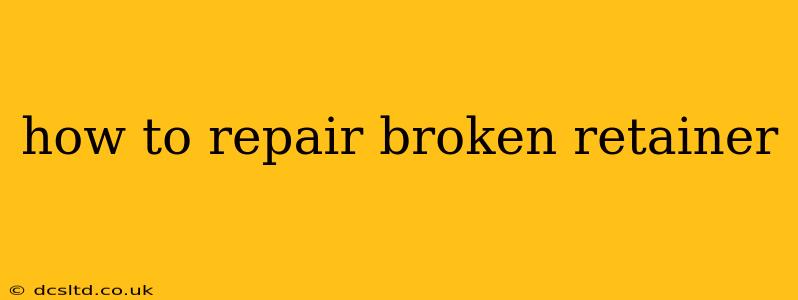A broken retainer can be incredibly frustrating, leaving you with an uncomfortable feeling and potentially hindering your orthodontic progress. This comprehensive guide will walk you through various repair options, from temporary fixes to professional solutions, ensuring you understand how to best address a broken retainer.
What to Do Immediately After Your Retainer Breaks?
The first step after discovering a broken retainer is to remain calm. Panicking won't fix the problem, and a measured approach will help you find the best solution. Immediately rinse the broken pieces with water to remove any food particles or debris. Then, carefully store all the pieces in a safe place, ideally in a container labeled with your name. This will be crucial if you need to take it to your orthodontist for repair.
Can I Repair My Retainer Myself?
While temporary fixes are possible, it's generally not recommended to attempt major repairs yourself. Improper repairs can lead to further damage to your teeth or gums. However, depending on the type of retainer and the nature of the break, some minor repairs might be manageable.
Temporary Fixes for Minor Breaks:
-
Small Cracks or Chips: For minor cracks or chips in a plastic retainer, you might use a retainer adhesive specifically designed for this purpose (available at some pharmacies). Apply a tiny amount carefully, following the product instructions. This is a temporary solution only.
-
Loose Wires (for wire retainers): If you have a wire retainer and a small wire is loose, you can carefully try to gently bend it back into place using clean tweezers. Be extremely cautious to avoid injuring your gums or mouth.
Important Note: These temporary fixes should only be used to keep the retainer in place until you can see your orthodontist. They are not long-term solutions.
How Can I Fix a Broken Retainer Wire?
Fixing a broken retainer wire requires precision and should ideally be done by a professional. However, if you find yourself in a situation where a professional isn't immediately available and only a small section of the wire is dislodged, you might consider:
- Using Dental Wax: Applying dental wax (available at most pharmacies) can help temporarily cover sharp edges of a broken wire, preventing irritation to your gums. This is a temporary solution only for discomfort management, not a structural repair.
How Much Does It Cost to Repair a Broken Retainer?
The cost of repairing a broken retainer can vary significantly depending on the extent of the damage, the type of retainer, and your location. It's best to contact your orthodontist directly for an accurate quote.
What Happens if I Don't Repair My Broken Retainer?
Ignoring a broken retainer can have several negative consequences:
-
Teeth Shifting: The primary function of a retainer is to maintain the position of your teeth after orthodontic treatment. A broken retainer may allow your teeth to shift, undoing all your hard work.
-
Discomfort and Irritation: Sharp edges or loose wires can cause discomfort, irritation, and even cuts in your mouth.
-
Further Damage: A broken retainer might cause further damage to your teeth or gums if not addressed promptly.
Should I Use Super Glue to Repair My Retainer?
Absolutely not. Super glue is not designed for use in the mouth and can be toxic if ingested. It can also damage your retainer further, making it harder to repair professionally. Never use super glue or any other household adhesive on your retainer.
How Do I Find a Qualified Orthodontist for Repairs?
If you need professional retainer repair, reach out to your original orthodontist first. They are most familiar with your specific case and will have the necessary tools and expertise for a proper repair. If that is not possible, ask for referrals from your dentist or search online for qualified orthodontists in your area.
Prevention is Key: How to Keep Your Retainer Intact
Preventing a broken retainer is crucial. Follow these tips:
-
Proper Cleaning: Clean your retainer regularly with a soft-bristled toothbrush and mild soap. Avoid abrasive cleaners.
-
Storage: When not in your mouth, store your retainer in its case to protect it from damage or loss.
-
Careful Handling: Avoid bending or dropping your retainer.
-
Regular Checkups: Attend regular check-up appointments with your orthodontist to monitor your retainer and identify any potential issues early.
By following these guidelines and seeking professional help when necessary, you can effectively address a broken retainer and protect your orthodontic results. Remember, prevention is always better than cure!
